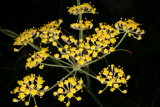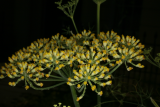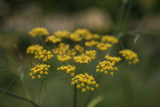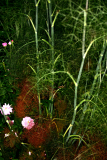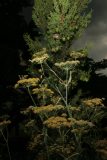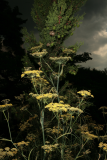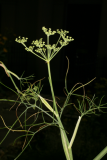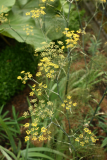Additional notes (click to expand)
Medicinal
Culpeper: “The root ... provokes urine and the Terms, strengthens the liver, and is good against the dropsie.”
Culpeper, Nicholas. (1650). A Physical Directory . London, Peter Cole. p.8
Culpeper (leaves)"Increaseth milk in nurses, provokes urine, breaks the stone, easeth pain in the reins [kidneys], opens stoppings, breaks wind, provokes the terms [menstrual periods].
Culpeper, Nicholas. (1650). A Physical Directory . London, Peter Cole. p.27
Medicinal uses
Uses supported by clinical data
None.
Uses described in pharmacopoeias and well established documents
Symptomatic treatment of dyspepsia, bloating and fl atulence (9, 23–25).
As an expectorant for mild infl ammation of the upper respiratory tract
(24, 26). Treatment of pain in scrotal hernia, and dysmenorrhoea (8).
Uses described in traditional medicine
Treatment of blepharitis, bronchitis, constipation, conjunctivitis, diabetes,
diarrhoea, dyspnoea, fever, gastritis, headache, pain, poor appetite and
respiratory and urinary tract infections (14). As an aphrodisiac, anthelminthic,
emmenagogue, galactagogue and vermicide (14, 27, 28).
Contraindications
The fruits are contraindicated in cases of known sensitivity to plants in
the Apiacaeae (69, 70). Owing to the potential estrogenic effects of the
essential oil from the seeds and anethole (44, 45, 50), its traditional use as
an emmenagogue, and the lack of human studies demonstrating effi cacy,
Fructus Foeniculi should not be used in pregnancy. Pure essential oils
should not be given to infants and young children owing to the danger of
laryngeal spasm, dyspnoea and central nervous system excitation (12).
Warnings
The pure essential oil from the fruits may cause inflammation, and has an
irritant action on the gastrointestinal tract.
WHO Monographs on Selected Medicinal Plants. Volume 3. 2007. WHO, Geneva
Medicinal uses
Uses supported by clinical data
None.
Uses described in pharmacopoeias and well established documents
Symptomatic treatment of dyspepsia, bloating and fl atulence (9, 23–25).
As an expectorant for mild infl ammation of the upper respiratory tract
(24, 26). Treatment of pain in scrotal hernia, and dysmenorrhoea (8).
Uses described in traditional medicine
Treatment of blepharitis, bronchitis, constipation, conjunctivitis, diabetes,
diarrhoea, dyspnoea, fever, gastritis, headache, pain, poor appetite and respiratory and urinary tract infections (14). As an aphrodisiac, anthelminthic,
emmenagogue, galactagogue and vermicide (14, 27, 28).
Contraindications
The fruits are contraindicated in cases of known sensitivity to plants in
the Apiaceae (69, 70). Owing to the potential estrogenic effects of the essential oil from the seeds and anethole (44, 45, 50), its traditional use as an
emmenagogue, and the lack of human studies demonstrating effi cacy,
Fructus Foeniculi should not be used in pregnancy. Pure essential oils
should not be given to infants and young children owing to the danger of
laryngeal spasm, dyspnoea and central nervous system excitation (12).
WHO monographs on medicinal plants commonly used in the Newly Independent States (NIS). 2010. WHO, Geneva
Other use
'In Fennel-seed, this vertue you shall finde,
Foorth of your lower parts to drive the winde'
'Of Fennell vertues foure they doe recite
First it hath poser some poysons to expell
Next, burning agues it will put to flight,
And fourthly, it doth keepe and cleanse the sight,
And thus the seed and hearbe doth both excell.'
Harrington (Translator), Sir John. (1608). The Englishman's Doctor or The School of Salerne. John Helme and John Busby Junior, Fleet Street.
In modern usage the leaves of Fennel are eaten as a garnish, raw or cooked, commonly with salads and fish. The cooked root is said to taste like parsnip.
Oakeley, Dr. H. F. (2013). The Gardens of the Pharmacopoeia Londinensis.
Toxicity
Contains estragole, an alkylbenzene, which is carcinogenic and genotoxic in rodents.
van den Berg, S.J.P.L., Restani, et al., P.. (2011). Levels of Genotoxic and Carcinogenic Compounds in Plant Food Supplements and Associated Risk Assessment. Food and Nutrition Science 2: 989-1010.
link
An oil made from the seeds is used in aromatherapy, but taken internally is toxic. The sap and fennel oil can cause dermatitis.
Oakeley, Dr. H. F. (2013). The Gardens of the Pharmacopoeia Londinensis.
Geographical distribution
- Africa, Macaronesia, Canary Is.
- Africa, Macaronesia, Madeira
- Africa, Northern Africa, Algeria
- Africa, Northern Africa, Egypt
- Africa, Northern Africa, Libya
- Africa, Northern Africa, Morocco
- Africa, Northern Africa, Tunisia
- Asia-Temperate, Caucasus
- Asia-Temperate, Western Asia, Afghanistan
- Asia-Temperate, Western Asia, Iran
- Asia-Temperate, Western Asia, Iraq
- Asia-Temperate, Western Asia, Israel
- Asia-Temperate, Western Asia, Jordan
- Asia-Temperate, Western Asia, Lebanon-Syria
- Asia-Temperate, Western Asia, Turkey
- Asia-Tropical, Indian Subcontinent, Pakistan
- Europe, Eastern Europe, Ukraine
- Europe, Southeastern Europe, Albania
- Europe, Southeastern Europe, Bosnia and Herzegovina
- Europe, Southeastern Europe, Bulgaria
- Europe, Southeastern Europe, Greece
- Europe, Southeastern Europe, Italy
- Europe, Southeastern Europe, Yugoslavia
- Europe, Southwestern Europe, France
- Europe, Southwestern Europe, Portugal
- Europe, Southwestern Europe, Spain
Podcast
Foeniculum vulgare Mill.
Family: APIACEAEGenus: Foeniculum
Species: vulgare Mill.
Common names: Fennel; Fenkell; Finckle
Pharmacopoeia Londinensis name: Foeniculum
Distribution summary: Mediterranean
Habit: Short-lived Perennial
Hardiness: H4 - Hardy; average winter
Habitat: Dry, grassy slopes amongst rocks , usually on calcareous soils
Garden status: Currently grown
Garden location: Pharmacopoeia Londinensis 1618 'Roots' (HSE 2)
Flowering months: August, September, October
Reason for growing: Medicinal, traditional herbal registration
